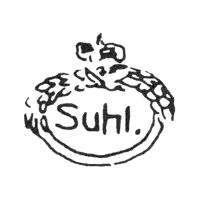
Image 011244-01-01
Used between 1861 and 1886.
(Picture: Rachel, Pam & Bruce)
What really confused collectors and dealers for quite some time is the fact that there were so many 'Schlegelmilch' factories. Although the different firm owners had the same surname, they represented the production efforts of two distinctly un-related families. These facts have been known since 1984, the year that Bernd Hartwich published his results after intensive research on the matter. But this information was not available in America until the English translation was published in the United States in 1993. The extensive historical research by Ron Capers shows there was no blood relationship between Leonard and Reinhold.
The facts are actually quite simple. The first facility was owned by Reinhold and the other facility was owned by Leonard, who had named his firm after his father, Erdmann. These two operations were in direct competition with each other and the factory owned by Reinhold (Reinhold Schlegelmilch = "R.S.", "R.S. Prussia") was subsequently run with his two sons, Ehrhard and Arnold. The latter took over an existing porcelain factory in Tillowitz in 1894 and continued to run it as part of the Reinhold Schlegelmilch enterprise until he died in 1934.
The firm owned by Leonard was later on led by Oscar, Julius Martin, and Carl. Carl opened his own factory in 1882 and Oscar started his own factory in Langewiesen during 1892. Julius Martin eventually took over the ownership of the Erdmann facility in 1899 after Leonard died.
This factory was founded and led by Leonard Schlegelmilch, who lived between 1823 and 1898. He named it in memory of his father, Erdmann Schlegelmilch, who had lived between 1782 and 1844. This Schlegelmilch facility mainly produced kitchenware, tableware, figurines, collector stuff and coffee or tea sets. After Leonard died in 1899, his son Julius Martin continued business and slowly expanded until they reached their peak employment count of 360 people in 1913.
Between around 1920 and 1930 the company also produced some porcelain bodies used for perfume lamps manufactured by the Aerozon company in Berlin. The number of employees dropped down to 250 in 1930 and following the world financial crisis the Erdmann Schlegelmilch facility ceased continuous production between 1933 and 1935, but some limited attempts were made to continue production prior to the final closing in 1937.
Noteworthy fact is that the factory also (re)decorated other items; there are quite a few items marked with the E.S. Prov.Saxe mark which were originally created at the Thomas factory from Marktredwitz/Bavaria. Next to the E.S. mark these items carry a golden cover-up which barely hides the original mark (e.g. Thomas "Sevres" Bavaria).
One of the marks used by this manufacturer is often referred to as the so-called beehive mark, which in reality represents a banded shield used first by the k.k. Ärarial-Manufactur Wien (Royal Porcelain Manufactury) in Vienna (Austria), but because so many people see it as a "beehive" (often due to incorrect application or use, standing on its head) that is what it has become known as. All "beehive" marks are extremely ambiguous and problematic because over the years many European porcelain manufacturers "borrowed" it or invented their own variation, thus making identification very difficult. In case of the beehive used by Erdmann Schlegelmilch though it is easily identifiable as it included a dot. This mark was frequently used on porcelain decorated with mythical, classical or allegorical scenes with borders typically held in deep wine, dark green or cobalt blue.
The last mark shown down below (also shown in the book "Marks of Prussia" by Ron Capers) is a distributor mark sometimes found on otherwise unmarked Erdmann Schlegelmilch items. Note that this does not mean that every item marked with this stamp automatically is a Schlegelmilch item!

Image 011244-01-01
Used between 1861 and 1886.
(Picture: Rachel, Pam & Bruce)
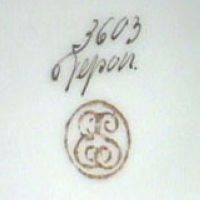
Image 011244-01-02
Used from 1861 until around 1891, stylized "ES" mark in red (also seen in green) with "Depon.", here with the pattern number '3603'.
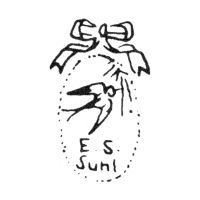
Image 011244-01-03
Used between 1886 and 1910, "Swallow" mark type 1
(Picture: Rachel, Pam & Bruce)
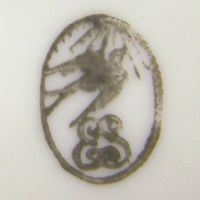
Image 011244-01-04
Used between 1886 and 1910, "Swallow" mark type 2. This can be found either in gold, red and green.

Image 011244-01-05
Used from 1891 onwards, another form of the crown mark.
(Picture: Pat Krusse)

Image 011244-01-06
Used from 1891 onwards, "Royal Saxe" green version.
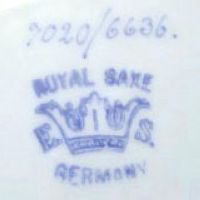
Image 011244-01-07
Used from 1891 onwards, "Royal Saxe" blue version. Nice view of mold number "7020" and pattern number "6636".
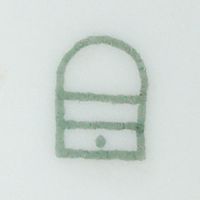
Image 011244-01-08
Used from 1891 onwards, "beehive" often found in combination with other marks.
(Picture: Markus Lehmeier)
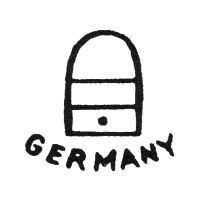
Image 011244-01-09
Used from 1891 onwards, "beehive" version with "Germany".
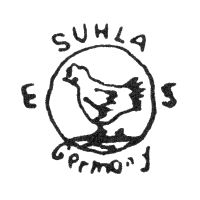
Image 011244-01-10
Used between 1896 and around 1910, the "Suhla" mark which was used either in red or blue.
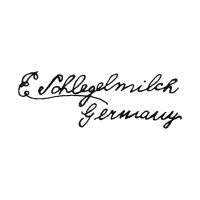
Image 011244-01-11
Used around 1900, handwritten "E. Schlegelmilch" above "Germany".
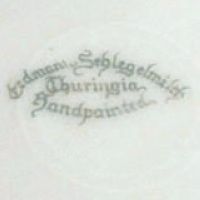
Image 011244-01-12
Used between 1900 and 1918, "Erdmann Schlegelmilch" above "Thuringia" and "Handpainted" found in green or blue.
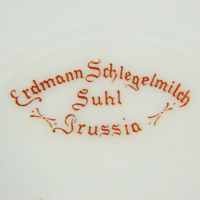
Image 011244-01-13
Used between 1900 and 1918, instead of "Thuringia" and "handpainted" stating "Suhl" and "Prussia".
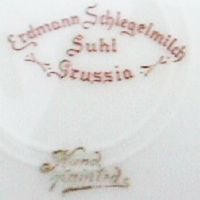
Image 011244-01-14
Used between 1900 and 1918, example of the previous mark with additional "hand painted".
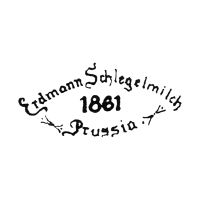
Image 011244-01-15
Used between 1900 and 1918, instead of "Thuringia" and "handpainted" stating "1861" and "Prussia".
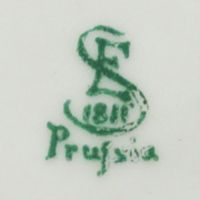
Image 011244-01-16
Used between 1900 and 1918, The "1811" is actually "1861" and "Prufsia" is correct as it's the form of double-"s" in old German writing.
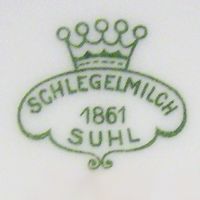
Image 011244-01-17
Used between 1900 and 1918.
(Picture: Susan Schweitzer)
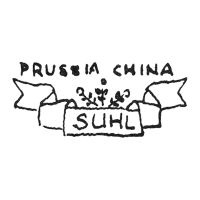
Image 011244-01-18
Used around 1900, "Prussia China" above "Suhl". Note clear form, smaller ribbons and missing "Germany".

Image 011244-01-19
Used around 1900, "Prussian China" mark in green.
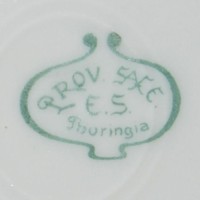
Image 011244-01-20
Used from 1902 onwards, "Prov. Saxe" mark stating "Thuringia".
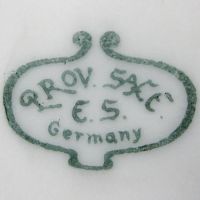
Image 011244-01-21
Used from 1902 onwards, "Prov. Saxe". Registered at the RWZR under №·54·161 on May 16th 1902.
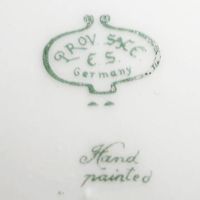
Image 011244-01-22
Used from 1902 onwards, here a version with "Hand painted" addition.
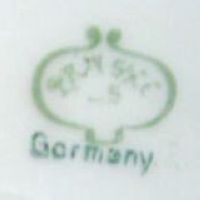
Image 011244-01-23
Used from 1902 onwards. In case the original mark transfer was incompletely applied, it was completed with a stamped "Germany" addition.
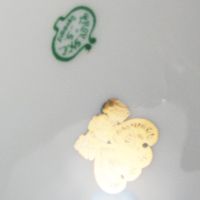
Image 011244-01-24
Another example, this time on a decorated item originally from Thomas in Marktredwitz (Bavaria).
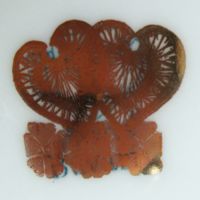
Image 011244-01-25
Here is a closeup of the golden cover-up which still allows to see the original manufacturer.
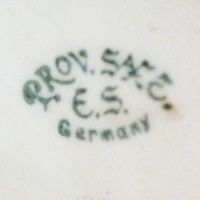
Image 011244-01-26
In a few cases, the mark was applied without the fancy border.
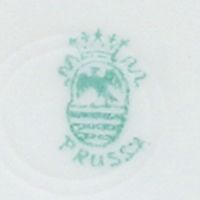
Image 011244-01-27
Used around 1938, another bird-related mark.
(Picture: Max Strachan)
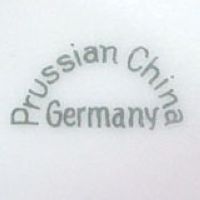
Image 011244-01-28
No date known, "Prussian China" mark, dark green.
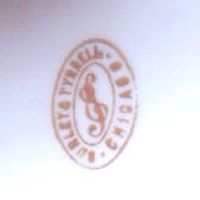
Image 011244-01-29
No date known, here the "ES" initials on an item made for US retailer Burley & Tyrrell from Chicago.
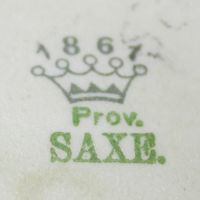
Image 011244-01-30
An undocumented mix of two mark forms found on untypical items, therefore often claimed to be a fake.
(Picture: Dmitriy Shvetsov)
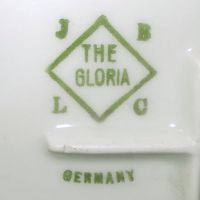
Image 011244-01-31
Initials "J.B.L.C." surrounding "The Gloria": distributor mark sometimes found on otherwise unmarked Erdmann Schlegelmilch items.
© 2004-2025 C.S.Marshall, all rights reserved